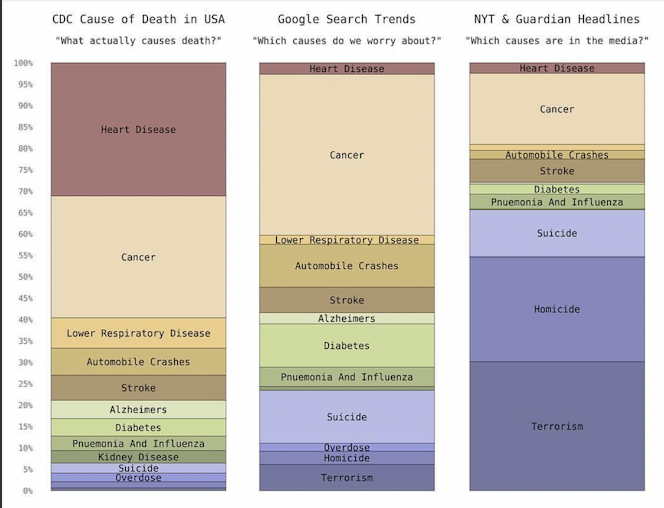I have a poster in my UNLV office that reveals how we think we’re going to die, how the media thinks we’re going die, and how we’re actually going to die.

The data shows that we’re worried about dying from cancer, the media is worried about us dying from terrorism, and yet we should all be most worried about dying of heart disease.
There are a lot of reasons why your heart could eventually kill you, but in most cases it comes down to modernity: We’ve engineered movement out of our days and high calorie, hyper-palatable foods into them.
American office workers sit on average anywhere from 7 to 13 hours daily, depending on which stat you read. The habit could be elevating our risk of mortality, obesity, and, of course, heart disease, that thing that’s going to kill us.
To find out just how artery clogging our modern, sedentary lifestyles are, scientists recently studied a completely unmodern group: The Hadza, a 1,200-member tribe of hunter-gatherers living in north-central Tanzania.
The scientists had tribe members wear heart rate monitors for two weeks, a method of determining activity levels. After two weeks of monitoring, the results showed that the Hadza move about 14 times more than the average American. In fact, they log about two hours and twenty minutes each day of moderate-intensity activity, such as walking at a quick pace, or lifting and carrying things.

Even many of the oldest tribe members, people in their late 70s, had basically no markers of heart disease.
What about food? Unlike us, the Hadza don’t eat Doritos, Big Macs, and milk shakes. They subsist on hunted meats, fruits, tubers, and honey.
And studies on Australian workers suggest diet might play a larger roll compared to movement. Aussie Blue collar workers each day sit just 1.6 hours and take 11,784 steps—roughly 5.5 to 6.5 miles of walking—according to researchers at the University of Queensland. If you assume it takes most people 15 minutes to walk a brisk (moderate intensity) mile, that’s 82.5 to 97.5 minutes of exercise. Not quite Hadza level, but it still puts these workers anywhere from 3.85 to 4.55 times above the CDC recommendation of logging 150 weekly minutes of moderate exercise.
Australian white collar workers, on the other hand, sit about 6.2 hours and take just 7,883 steps each day. But does that relative lack of physical activity affect their heart heath more? Not according to this study. Here’s the data:

The blue collar workers died from heart disease at about double the rate of the white collar workers. What’s going on here? Studies suggest diet and lifestyle is the factor—blue collar workers consume lower-quality diets and are more likely to smoke.
So what does the Hadza study tell us? That modernity is driving us in the wrong direction when it comes to heart health. We’re moving far less and eating differently than we used to, and that “old way”—the Hadza way—seems to be far better for our hearts.